Arts & Culture
About Andrew Cusack
 Writer, web designer, etc.; born in New York; educated in Argentina, Scotland, and South Africa; now based in London.
Writer, web designer, etc.; born in New York; educated in Argentina, Scotland, and South Africa; now based in London. read more
News
Blogs
Reviews & Periodicals
Arts & Design
World
France
Mitteleuropa
Knickerbockers
Argentina
The Levant
Africa
Cape of Good Hope
Netherlands
Scandinavia
Québec
India
Muscovy
Germany
Academica
They don’t all hate us
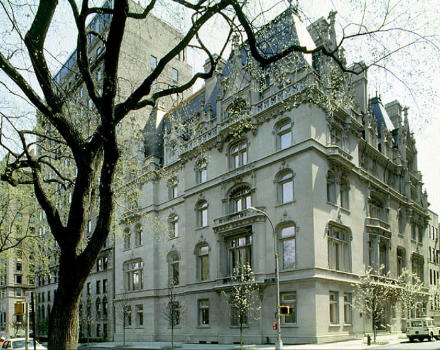
THE JEWISH MUSEUM sits at the corner of 91st Street and Fifth Avenue in the old Warburg mansion. It was expanded in 1993, nearly doubling its frontage on the avenue. See the modern addition? No? That’s the point.
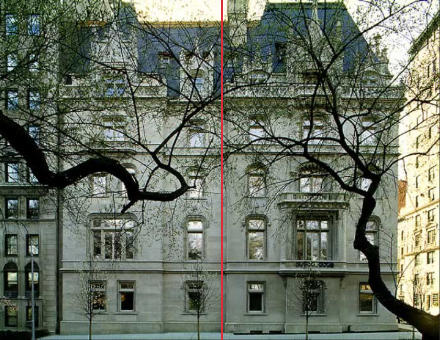
In the photograph above, the section to the right of the red line is the original Warburg house, built in 1909 and designed by C.P.H. Gilbert. The section to the left of the red line is the 1993 addition. If only the directors of the Morgan Library and the Brooklyn Museum had been similarly inspired.
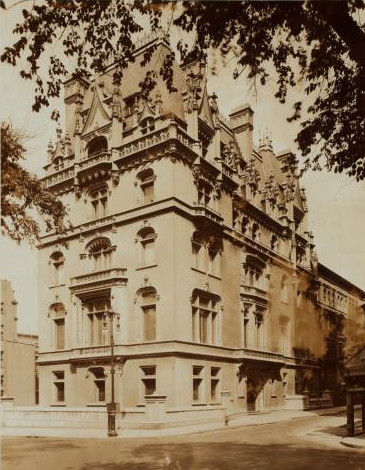
Missal Mania

Baronius Press have reported a doubling in their sales of missals for the old Mass, or the “extraordinary form” as we are to call it now, since the release of the motu proprio Summorum Pontificum. Readers will be shocked to hear that I am actually a reactionary (however accidentally) because I only have a 1960 missal, not the 1962 missal which is the actual missal used at traditional masses. However, I would not object if anyone would like to gift me a brand spanking new 1962 daily missal from Baronius Press. The perfect gift for young Catholics: St. Nicholas Day is just around the corner! (Alright, over two months away, but still…).
Baronius Press are also coming out with the Little Office of the Blessed Virgin Mary, which has received an Imprimatur and will be available from sometime in October.
The Teatro Colón in Buenos Aires
Finest opera house of the New World
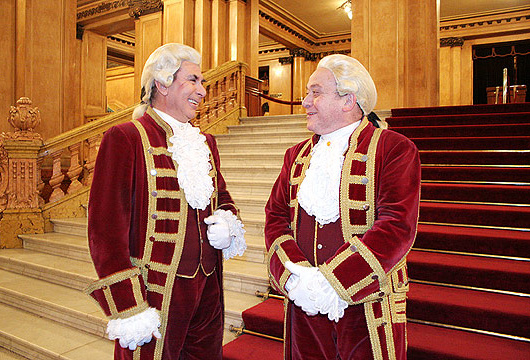
Am I old-fashioned, or aren’t footmen not supposed to smile?
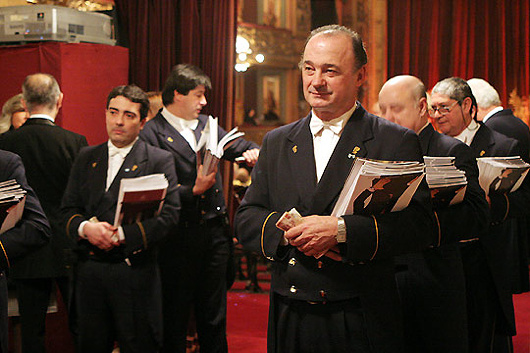
This usher knows precisely how much (which is to say, how little) emotion to show.
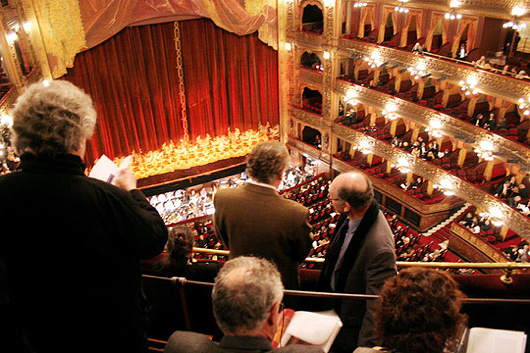
But now, everyone to their seats…
The magnificent Teatro Colón is currently closed for refurbishment until 25 May 2008, when the most prominent opera house under the Southern Cross will reopen brighter and better than ever.
A Mews in London
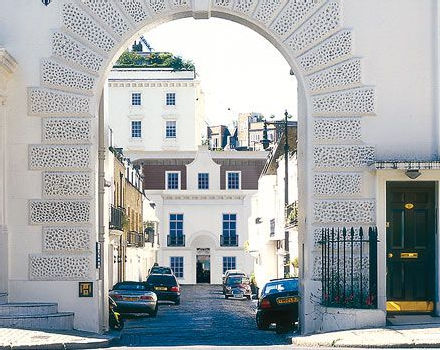
Typical London, and yet the gable on Lion Lodge (the building which terminates the view), together with the general white-wash of the façades, gives it a hint of Cape Town. Lion Lodge is a recent structure by Liam O’Connor Architects and Planning Consultants.
The Rathaus of Gladbeck
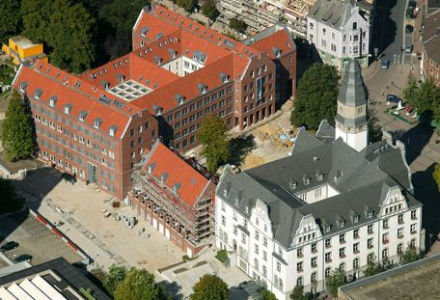
JUST SO YOU ARE aware that not all the architects hate us, let us travel to the Westphalian town of Gladbeck where the city fathers, in their infinite sagacity and wisdom and ever open to changes in inclination, have seen fit to correct the errors of the not-too-distant past by tearing down two hideous concrete boxes and replacing them with a more appropriate annex to the handsome art-nouveau Rathaus (town hall). The man to thank, apparently, is Gladbeck’s Stadtbaurat (town planning advisor) Herr Michael Stojan (a tweedy sort of fellow, it appears), who initiated the project. What a pity the directors of the Morgan Library could not exercise a similar wisdom.
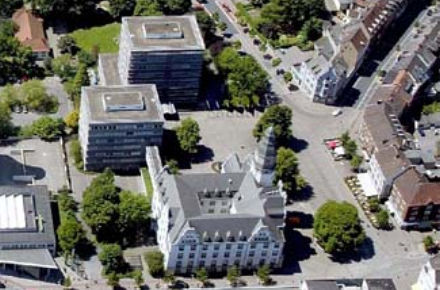
Gladbeck’s ‘Willy Brandt Platz’ before the offensive structures were removed.
The new building is modern but not modernist, and has no pretensions to being the original Rathaus’s contemporary. It exhibits a certain simplicity, and while it lacks exterior ornamentation it does not suffer much from that absence. Internal courts provide natural light to the offices within, while arcades offer shelter to passers-by in the event of an impromptu opening of the heavens. With its saddleback gables, the annex complements but does not compete with the town hall it is intended to augment. Improvements such as this are deserving of our applause.
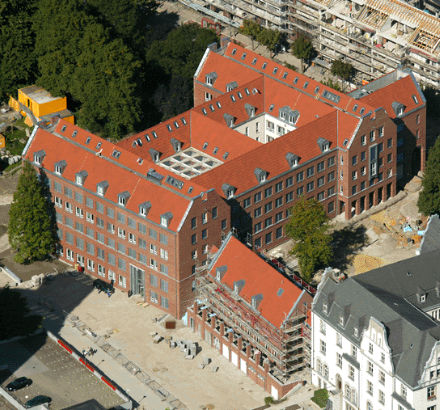
Elsewhere: Die Welt: Wie sich eine Stadt repariert (12 April 2007)
The Architects: They Really Hate Us
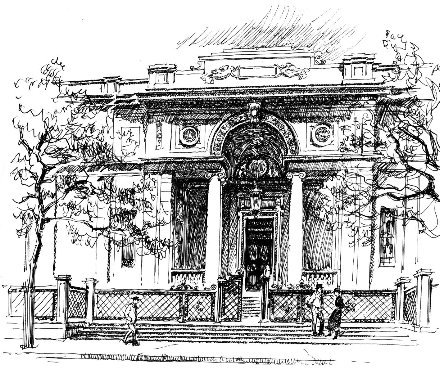
ONE OF THE GREAT things about the Morgan Library on 36th and Madison was that it used to reflect (and indeed protect) the glories of European civilization. Since its recent renovation, however, it merely expresses the post-civilization status of the mother continent. One cannot help but feel bad for poor Mr. Morgan, who would surely frown upon the vulgarity which has been thrust upon his life’s achievement: one of the finest collections of manuscripts, rare books, and drawings in the entire world. (more…)
The Old Archbishop’s Palace, New Orleans
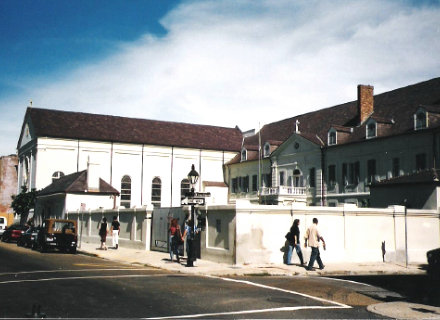
BUILT IN 1745, the Old Archbishop’s Palace in New Orleans is believed to be the oldest building in the entire Mississippi Valley. The building has gone through a number of ecclesiastical uses through the centuries, originally constructed to French plans for the Ursuline sisters who came to foster the Christian faith in la Louisiane. On the corner of Chartres Street and Ursulines Avenue in western corner of the Vieux Carré, the Convent survived the Great Fire of 1788, along with the neighboring barracks and Royal Hospital. The Ursuline nuns took orphans into their care here, and educated the daughters of the city’s elite and of the local plantation owners (among them Baroness Pontalba), as well as organizing special handiworks classes for Indian and Negro girls. And it was in the Chapel of the Convent that the Ursuline nuns kept vigil during the Battle of New Orleans in 1815, praying ceaselessly for the salvation of New Orleans from destruction. This great event was attributed to the Blessed Virgin, and Notre Dame de Bon Secours (Our Lady of Prompt Succour) was adopted as the patron of the city and diocese of New Orleans and the state of Louisiana. (more…)
Nederlands Dagblad
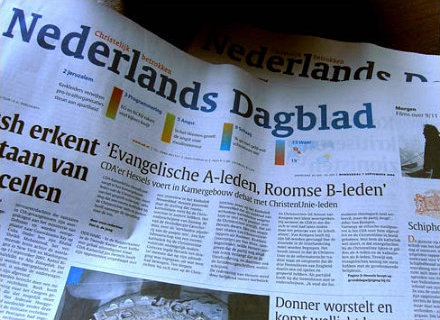
ONE ENVIES the Dutch for having a quality, serious Christian daily newspaper, Nederlands Dagblad (“Netherlands Daily”), even if it is Protestant-run and -oriented. A daily newspaper since 1967, ND currently has a circulation of 33,000. The circulation has been increasing in the past few years, reportedly among non-Christians who desire an alternative perspective from that of the mainstream newspapers. Could not the same be replicated in America, perhaps even on a Catholic basis?
Ludlow Street
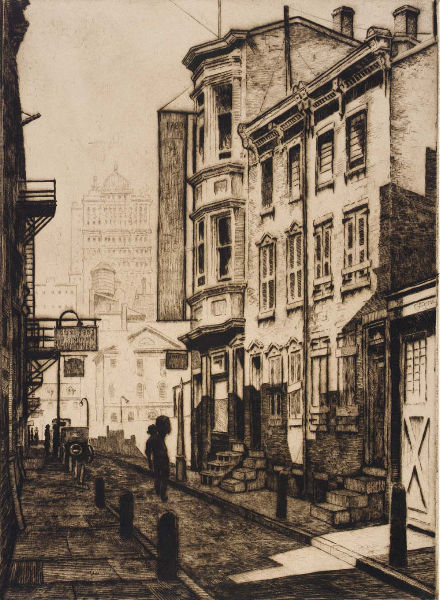
George A. Bradshaw, Ludlow Street
Drypoint on paper, 8 7/8 ” x 6 3/8 ”
1935, Smithsonian American Art Museum
Ludlow Street is the home of the world-famous Katz’s Delicatessen.
New Netherland Medal

Paul Manship, New York Tercentenary Medal
Bronze, 2 3/4 inch diameter
1914, Smithsonian American Art Museum
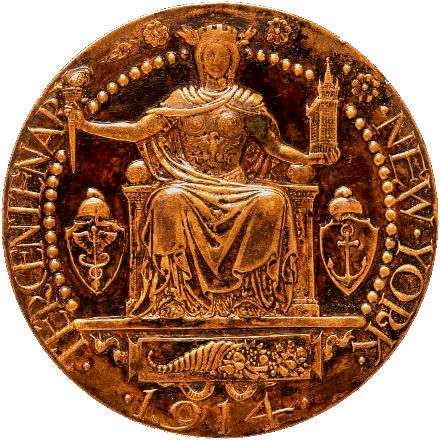
The Edificio Metrópolis, Madrid
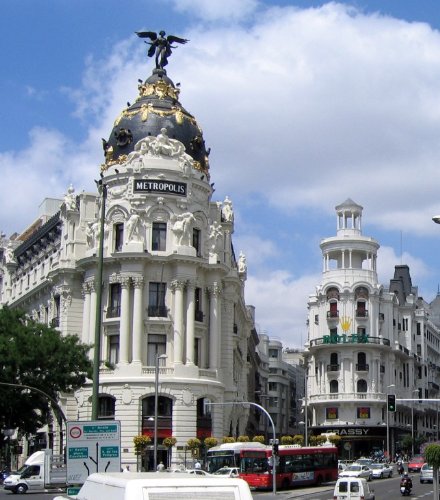
WHERE THE GRAN VÍA meets up with the Calle Alcalá in Madrid, there is a wonderful building which these days is known as the edificio Metrópolis. Designed by Jules and Raymond Février of France, it was built in 1911 for the Union and Fénix insurance company. The architects took advantage of the awkward but prominent site to create a landmark building for the company, one of the largest insurance firms in Spain. At the apex of its triangular site is a splendidly decorated round tower, originally topped by the Union and Fénix symbol of a phoenix with Ganymede. (more…)
Salve Regina

ONE OF THE MORE unfortunate aspects of the twentieth century was the decline of the country house in the British Isles and North America during the post-war period. Innumerable homes of great history and beauty were lost to the wrecking ball and the developer’s avarice. Newport, the former capital of the Colony of Rhode Island and Providence Plantations, became a summer capital to many of America’s well-to-do during the so-called “gilded era”. (It was avowed then that the highest level of society was determined by those whom Mrs. Vanderbilt could fit in the great hall of her Newport house). While many of the great homes of Long Island fell to ruin after the war, and the legendary Meadowbrook Hunt dissolved, many of the best Newport homes found a welcome new role under the wings of Salve Regina University, the city’s Catholic university. The decline of these great houses and the ascent of Salve Regina proved a quite fortunate coincidence, and has inspired the university to start one of the first academic programs in historical preservation and restoration. These great summer ‘cottages’ now house lecture halls, seminar rooms, academic offices, dormitory space, and a Catholic chapel. They are appropriate surroundings for Western civilization to be passed on to the next generations. (more…)
Film of the Year: “Zwartboek”

UNQUESTIONABLY: “Zwartboek”, or “Black Book” as it was released here in the United States. Sebastian Koch you will recall from “Das Leben der Anderen” (which, come to think of it, probably ties with “Zwartboek” for film of the year), while Carice van Houten will be in the next James Bond flick.
But is it better than director Paul Verhoeven’s previous Dutch World War II film, “Soldaat van Oranje”? Difficult choice! Happily, both films display a certain monarchist tendency.
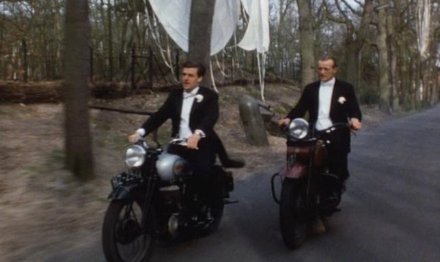
The Dahlgren Residence
No. 15 East Ninety-Sixth Street, New York
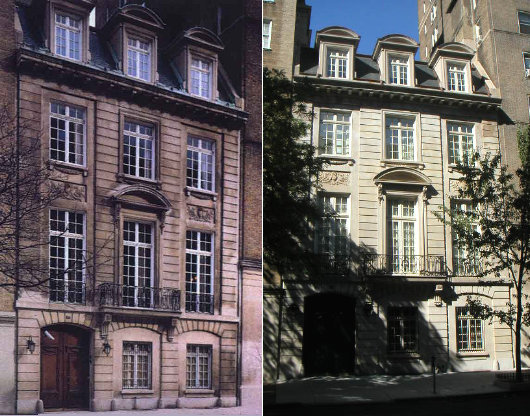
THE UPPER EAST SIDE is crossed by a number of wider cross-streets, of which 96th Street has long been agreed as the northern boundary of the neighborhood. (Overeager real estate agents have recently taken to advertising properties above that boundary as being located in the “Upper Upper East Side”). At number 15 on East 96th Street sits a splendid townhouse of superb design and execution often known as the Dahlgren residence. (Seen above, before and after complete restoration).
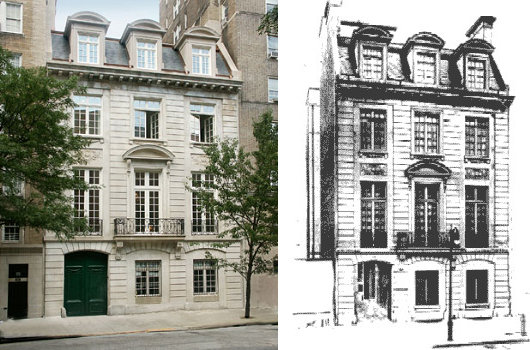
Lucy Wharton Drexel was of the Philadelphia Drexels, from which also came Saint Katharine Drexel, the founder of the Sisters of the Blessed Sacrament, as well as the initiators of Drexel University in that Pennsylvanian city. Young Miss Drexel married Mr. Eric B. Dahlgren, son of Admiral John A. Dahlgren, inventor of the Dahlgren Gun used during the Civil War at a ceremony in the Philadelphia cathedral officiated by Archbishop Corrigan of that see, and the couple soon moved to Manhattan where Mr. Dahlgren had a seat on the New York Stock Exchange. The Dahlgrens themselves were a prominent Catholic family, with Eric and his brothers attending Georgetown University, where to this day the main chapel bears the Dahlgren name. (Well-to-do Catholics must have been in short supply at the time, because after Lucy and Eric’s marriage, Lucy’s sister Elizabeth was married to Eric’s brother John).
Diary

EARLY YESTERDAY EVENING I found myself on the West Side and with a bit of free time, so I sauntered down Broadway to Columbus Circle to finally investigate in the flesh this great public place after its complete rehabilitation some two years ago. I am happy to report that the Circle’s refurbishment is quite a successful one. My only reservations were minor details, but as these were all done in an extremely simple and smooth modern style, they are much less objectional, and perhaps serve to focus attention on the sculptor Gaetano Russo’s splendid monumental column from which Cristóbal Colón, Admiral of the Ocean Sea, Viceroy and Governor of the New World presides over the grand plaza consecrated to his memory.
Colón’s name is rendered on the monument as ‘Cristoforo Colombo’, which seems appropriate since the monument was paid for by public subscription raised by Italian-Americans, and it is commonly assumed that Columbus was Italian. He may have been Genoese, Catalan, Portuguese, or Corsican, but he described himself as being from lands under the rule of Genoa, which lends significant credence to the Genoese and Corsican theories. In Spain, however, he is apparently Spanish, or so one daughter of Iberia, the wife of a frequent reader of this little corner of the web, informs us. The happy couple were strolling through Columbus Circle recently and the good lady was shocked to discover the purported Italian origin of the man who brought Christianity to the New World. After all, Spain’s national day — the Día de la Hispanidad — is October 12, the day in 1492 that Columbus first set foot in the New World. (In woebegone Venezuela, the vulgar socialist dictator has proclaimed October 12 as the Día de la Resistencia Indígena, or Day of Indigenous Resistance, and the Columbus Column in their capital city of Caracas was toppled on that day in 2004).
Anyhow, not only was the good lady was shocked at our monument’s proclamation of the Discoverer’s Italian-ness but the combination of that with the presence in Columbus Circle of the beautiful U.S.S. Maine Monument led the observer to conclude that the public plaza should be instead be named “Anti-Spain Square”. It was the disastrous sinking of the Maine, after all, which led to the Spanish-American War, the result of which was America’s most unfortunate and regretful act of taking Spain’s empire off her hands. (Contrary to Mr. Kipling’s idealistic urging of America to take up the imperial mantle in his poem ‘White Man’s Burden’, this turned out to be a fairly good deal for the Spaniards, and a very poor deal for the peoples of the United States).

Politics aside, I enjoyed the few minutes during which I ruminated in the square (or circle, if ye be pedants). I recall many years ago the debate surrounding how to improve Columbus Circle that there was a near-universal desire for there to be more trees but that the very shallow depth between the street surface and the subway below presented difficulties in this regard. The redesigners have solved this problem by encircling the center of the circle with a raised ridge, on which are planted a number of trees which, we trust, will be even more appreciated as they mature. The raised ridge, which features jets of flowing water around the inner circle, also serves to innoculate the center from the noise of the traffic which, the Circle being situated at the confluence of Broadway, Central Park West, Central Park South, and Eigth Avenue, is considerable.
And so, I judge the new Columbus Circle a success, and I am happy to the report that the American Society of Landscape Architects concur, having awarded it their General Design Award of Honor. Another random fact which surprisingly few people know is that Columbus Circle is the spot from which distances to New York are numerated, akin to Moscow’s Red Square and London’s Trafalgar Square (if I recall correctly).
LEAVING COLUMBUS CIRCLE, I sauntered back up Broadway to another of Manhattan’s engaging places, Lincoln Center. Critics accused the architects of the performing arts complex of cribbing off of Rome’s E.U.R., but one wishes the three halls facing Lincoln Center’s plaza had the same crispness of those modern Roman structures. The thirty years between the E.U.R. of 1930s Italy and the Lincoln Center of 1960s New York were years in which the quality of modernism declined just as greatly as its supremacy increased. Despite this, the plaza of Lincoln Center is one of the most successful public places in Manhattan. I have often lamented the absence from New York of the open piazza so common on the Continent. This plaza competes with Central Park’s Bethesda Terrace as the best example of the type in Manhattan.

The plaza is raised above the neighboring Lincoln Square (one of the many triangular squares created by Broadway’s healthy disregard for the grid) and is reached by a gentle rise of stairs. Viewed from the square it appropriately seems like a stage upon which all our great dramas are played. The dance of the New York City Ballet in the State Theatre on the left, the music of the New York Philharmonic in Avery Fisher Hall on the left, and in the center, the Metropolitan Opera in the Metropolitan Opera House; the greatest opera company in the Americas, not to mention one of the best in the entire world. And from the hour of seven or so on the evening of performances, the three arts mix and mingle in the plaza as attendées wait to meet their companions and enter whichever of the respective halls they are to spend the evening. Some jealously preserve a seat of honor on the rim of the central fountain, while others hide from the elements (the beating sun, the heaving rain) in the shelter of the arcades, while still more meander slowly to and fro around this piazza dell’arte.
It’s unfortunate, then, that the elders of Lincoln Center insist on erecting temporary stage structures in the middle of the plaza, partially obstructing the fountain, during the warmer months when, above all other times, it should be open for all to enjoy. The creators of Lincoln Center conceived of the obvious desire for outdoor performances during the summer, and so they built the bandshell in Damrosch Park in between the Opera House and Avery Fisher Hall, just diagonally adjacent to the plaza. Surely the plaza is meant to be an open space where all the events can mix, blend, interact, influence, before finally separating into their appropriate places. If there are to be outdoor performances, hold them where they were meant to be, and if that place suffers from some malfunction of design, then redesign that place rather than rudely interjecting a particular event into what was meant to be the public square for all.
THIS PARTICULAR EVENING it was into Avery Fisher Hall for a performance of the New York Philharmonic, now in its 165th year. The program was Rossini’s overture to Semiramide and Schubert’s Symphony No. 3 in D major (D.500), with Dvořák’s Symphony No. 5 in F major (Op. 76). Riccardo Muti wielded the conductor’s baton and the result was definitely less than was expected. I had only heard Muti’s conducting on the radio in passing and, while admittedly not devoting much thought to it, he seemed a fairly capable conductor. In person, however, he left much to be desired. Rossini’s overture was merely lackluster but Schubert’s symphony was actually surprisingly poor. Perhaps the worst thing was observing Muti in action, for the man looked like an utter fool. His conducting seemed unnatural, choreographed, even foppish. And those ridiculous jestures towards the first violins! I wanted to slap the man, and I shouldn’t be surprised if the violins wanted to themselves. Towards the middle of the Schubert symphony, I began to think of the man as a proper ass, the tails of his evening jacket acting the part of hind legs. My only solution to the St. Vitus’s dance on the conductor’s dais was to shut my eyes and imagine that I was there in the Austrian capital in that autumn of 1815, after the chancellors and ministers of the crowned heads of Europe had departed the Congress of Vienna when peace and order were plotted, in the home of Otto Hatwig where (scholars posit) the work was premiered.

The friend I accompanied that evening actually knows about the inner workings of music (I am actually an ignoramus on the subject, and simply like what sounds good to me) and agreed completely with me on the subject during the intermission. Luckily, the Dvořák fared better, but one had the niggling suspicion that this was the Philharmonic working its magic in spite of Mr. Muti, rather than at the command of his baton. My knowledge and appreciation of Dvořák has slowly grown, from that first passing fondness we all have for his Symphony No. 9 “From the New World”. My appreciation for the Philharmonic grows, when I see they have printed in the program that Mr. Dvořák was born in Mühlhausen, Bohemia, rather than the more modish style of “Nelahozeves, Czech Republic” that would find favor elsewhere.
Perhaps I am too hard on Mr. Muti. Perhaps he and the Philharmonic were simply not a good fit for eachother. At any rate, I shouldn’t complain as one doesn’t often get box seats to a sold-out performance with every seat in the hall occupied (though, to be honest, the sound is better down in the orchestra seats). But how I wish I could have seen von Karajan while he was alive!
After the baton had finally fallen for the night, my friend and I had the same stroke of genius at exactly the same moment and decided to head up to good old Café Lalo, but unfortunately everyone else had the same idea (Saturday night? Lalo’s? What did we expect?) so we comforted ourselves with a pint or two at the Parlour instead.
Peter Simple V
A wise old man once said ‘good fences make good neighbours’ but history is chock full of territorial disputes nonetheless. Woefully, ancient land claims and cross-border irridentism reared their ugly head on the pages of the Daily Telegraph as well. These two columns, the fifth installment in our series introducing you to the greatest newspaper columnist who ever lived and breathed, retells just such a territorial dispute which erupted over changes in the layout and denomination of the newspaper page on which the Peter Simple column perenially (since the dawn of time, beyond the age of our forefathers) appeared.
A Small Crisis
 For some time now, the eastern part of the region in which my column occasionally appears has been headed “End Column” no matter what appears on it, whether literary criticism, humour or chess (which has taken permanent occupation of the southern part of the territory). Then one morning the world woke to a startling innovation: the territory was simply headed “Chess”. What had happened? Had an extremist group of chess writers suddenly claimed sovereignty over the whole region? It was the more surprising in that of all the paginal powers, Chess, devoted as it is to pure intellect, has historically always been the least aggressive, well satisfied with the ample territory it occupies and threatening no other power.
For some time now, the eastern part of the region in which my column occasionally appears has been headed “End Column” no matter what appears on it, whether literary criticism, humour or chess (which has taken permanent occupation of the southern part of the territory). Then one morning the world woke to a startling innovation: the territory was simply headed “Chess”. What had happened? Had an extremist group of chess writers suddenly claimed sovereignty over the whole region? It was the more surprising in that of all the paginal powers, Chess, devoted as it is to pure intellect, has historically always been the least aggressive, well satisfied with the ample territory it occupies and threatening no other power.
A serious diplomatic incident followed. Our own columnar government was not slow in sending a strong protest to the chess authorities. Partial mobilisation was ordered. A squadron of Blériot Mark II reconnaissance aircraft was sent to patrol the whole area. A gunboat of the Don Carlos class was despatched to the Interpaginal Sea.
Fortunately, the traditional panic and flight of the peasantry was quelled in time. Soon, wiser counsels prevailed and the crisis evaporated as rapidly as it had arisen. But it cannot be too strongly emphasised that in the event of a serious threat to the paginal balance of power, the column could not and would not stand idly by. For although this column is not always corporeally present in the eastern territory it is always present in a metaphorical and mystical sense, in all the territories where it has ever been.
Signs and Wonders
AS veteran readers of this column will recall (“Are there any others?” our boring expert “Narcolept” never fails to ask), a diplomatic impasse was caused last month when the chess flag was raised over the territory formerly known as “End Column”, implying an exclusive claim to suzerainty over a territory shared by other powers including ourselves.
The situation was supposed to have been normalised when, as is so often the case, wiser counsels prevailed. Sadly, this is not so. Extremist elements in the column, who have long been impatient with its conciliatory policy, are thought to be planning direct action by launching a surprise attack on the heartland of chess itself, the southern region in which its authority has never been disputed, and setting up a puppet state with only nominal allegiance, perhaps, to the parent column.
Are these hotheads and firebrands harking back to the so-called “time of troubles” in the 1970s, the time of “Peter Simple II” and the labyrinthine intrigues that led to a coup by General Waugh and the present “binary” dispensation? As a timely pronunciamiento from the Ministry of Columnar Guidance warns, “Such irresponsible day-dreaming could have the gravest possible consequences,” even leading to the onset of the long dreaded Fimbul Winter and the end of the column itself.
To make matters worse, certain elements seem bent on defying the basic columnar Law of Non-Interaction, which prevents different aspects of the column from interfering with each other. For example, it is rumoured that certain senior officers of that normally inactive regiment, the Stretchfordshire Yeomanry, are sympathetic to the extremists and, in the event of an attack on the chess territory, might join an expeditionary force (which would be styled a “liberation army”). As the pronunciamiento insists, this would be “playing with fire”.
Nor is this all. General Sir Frederick (“Tiger”) Nidgett, veteran war hero, founder of the Royal Army Tailoring Corps and Saviour of Port Said in the “dark days of 1942 when the Nazi hordes were bawling tastelessly at the gates of Egypt” – see Nidgett’s autobiography Up Sticks and Away (Viper and Bugloss, £25; paperback, £15; bulk orders welcomed) – is reported to have offered his services to the insurgents as military adviser and expert on combined operations. In a startling development, sources in the Columnar Foreign Office have dismissed Nidgett as “a buffoon and play actor whose boasted wartime service was in fact confined to looting bales of cloth and blackmailing shopkeepers in the bazaars of Cairo”. But a statement issued “from the desk of Gen Sir Frederick Nidgett” countered these criticisms with a firm “no comment”. Members of the Tailoring Corps Veterans Association have already hit back in defence of their founder, threatening reprisals with their traditional weapons, the dreaded armoured trouserpresses, failing an immediate withdrawal and apology.
To add to the confusion and breakdown of basic columnar principles, Sir Alywin Goth-Jones, the unpopular chief constable of Stretchford, has offered to place a squadron of his controversial police submarine force (currently patrolling the lake in sex-maniac-haunted Sadcake Park in pursuit of drink-drivers) at the disposal of the proposed expedition for a landing on the supposedly undefended shores of chess’s southern territories.
The pronunciamiento goes on to say that the extremists have “stirred up a veritable hornets’ nest and it is high time wiser counsels prevailed”. But will this deter irresponsible hotheads encouraged by intelligence reports, almost entirely fallacious, of growing dissent within chess itself, and signs of a modernising tendency which would put this noble and august game under the control of that most un-English authority, the Ministry of Sport?
This would lead to assimilation in the West Midland Chess League, responsible for the up-to-the-minute vandalism and hooliganism which mark the disgustingly popular annual matches between Stretchford Chess Circle and Nerdley Boardsmen, when drunken fans invade and overturn the board, and even assault the pieces without distinction between queen and pawn.
As the pronunciamiento inevitably states, it is time to draw back from the precipice. Equally, it cannot be too strongly (or too often) emphasised that, in the event of a serious threat to the paginal balance of power, this column could not and would not stand idly by.
For Saint George
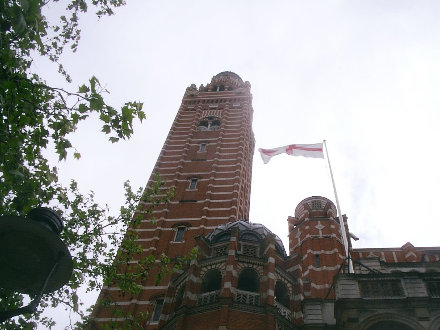
THE CROSS OF SAINT GEORGE snaps proudly from the flagpole above Westminster Cathedral, the Administrator of which, Msgr. Mark Langham, has given us a special St. George’s Day treat by revealing the newly-commissioned designs for completing the mosaic work in that cathedral’s chapel dedicated to the patron saint of England.
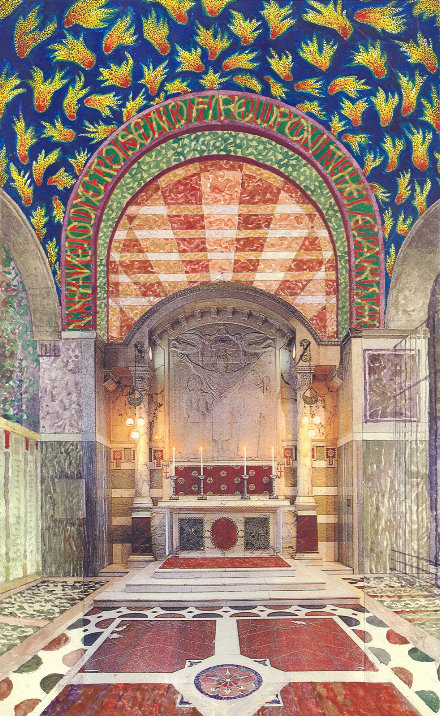
Felix Meritis
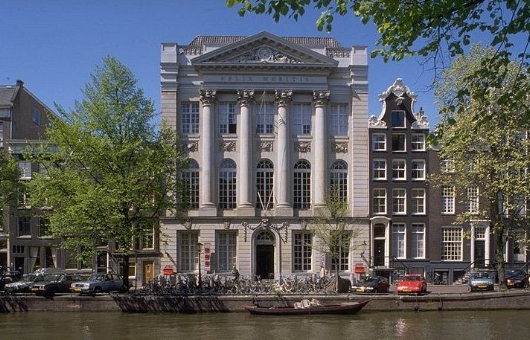
ONE OF MY FAVORITE handsome and dignified, and yet relatively small, buildings is the Felix Meritis on the Keizersgracht in Amsterdam. It has a long and interesting history to accompany the beauty of its design. The ‘Felix Meritis’ was a learned society founded by a number of prominent burghers of Amsterdam in 1777 for the promotion of the arts and sciences in their city. Its name is Latin for ‘fortunate (or more literally, ‘happy’) by merit’. Ten years later, the Felix Meritis purchased four narrow homes on the Keizersgracht and constructed a building, designed by the architect Jacob Otten Husly, on the site. (more…)
Search
Instagram: @andcusack
Click here for my Instagram photos.Most Recent Posts
- Amsterdam November 26, 2024
- Silver Jubilee November 21, 2024
- Articles of Note: 11 November 2024 November 11, 2024
- Why do you read? November 5, 2024
- India November 4, 2024
Most Recent Comments
- on The Catholic Apostolic Church, Edinburgh
- on Articles of Note: 11 November 2024
- on Articles of Note: 11 November 2024
- on Why do you read?
- on Why do you read?
- on University Nicknames in South Africa
- on The Situation at St Andrews
- on An Aldermanian Skyscraper
- on Equality
- on Rough Notes of Kinderhook
Book Wishlist
Monthly Archives
Categories




